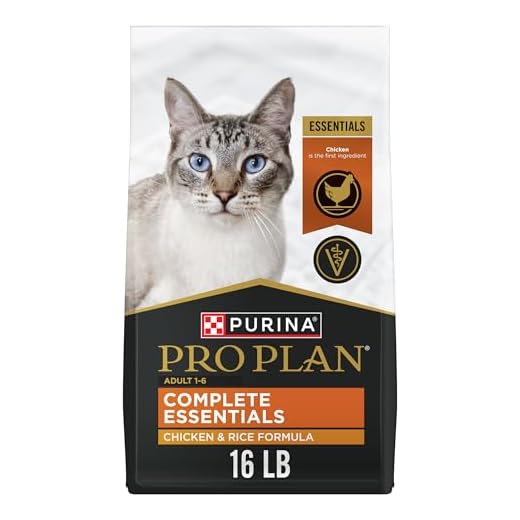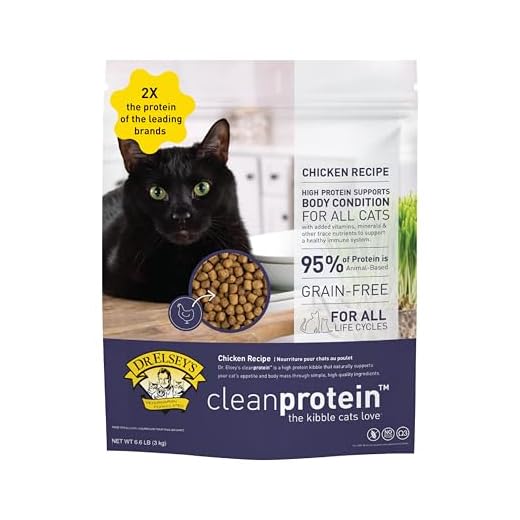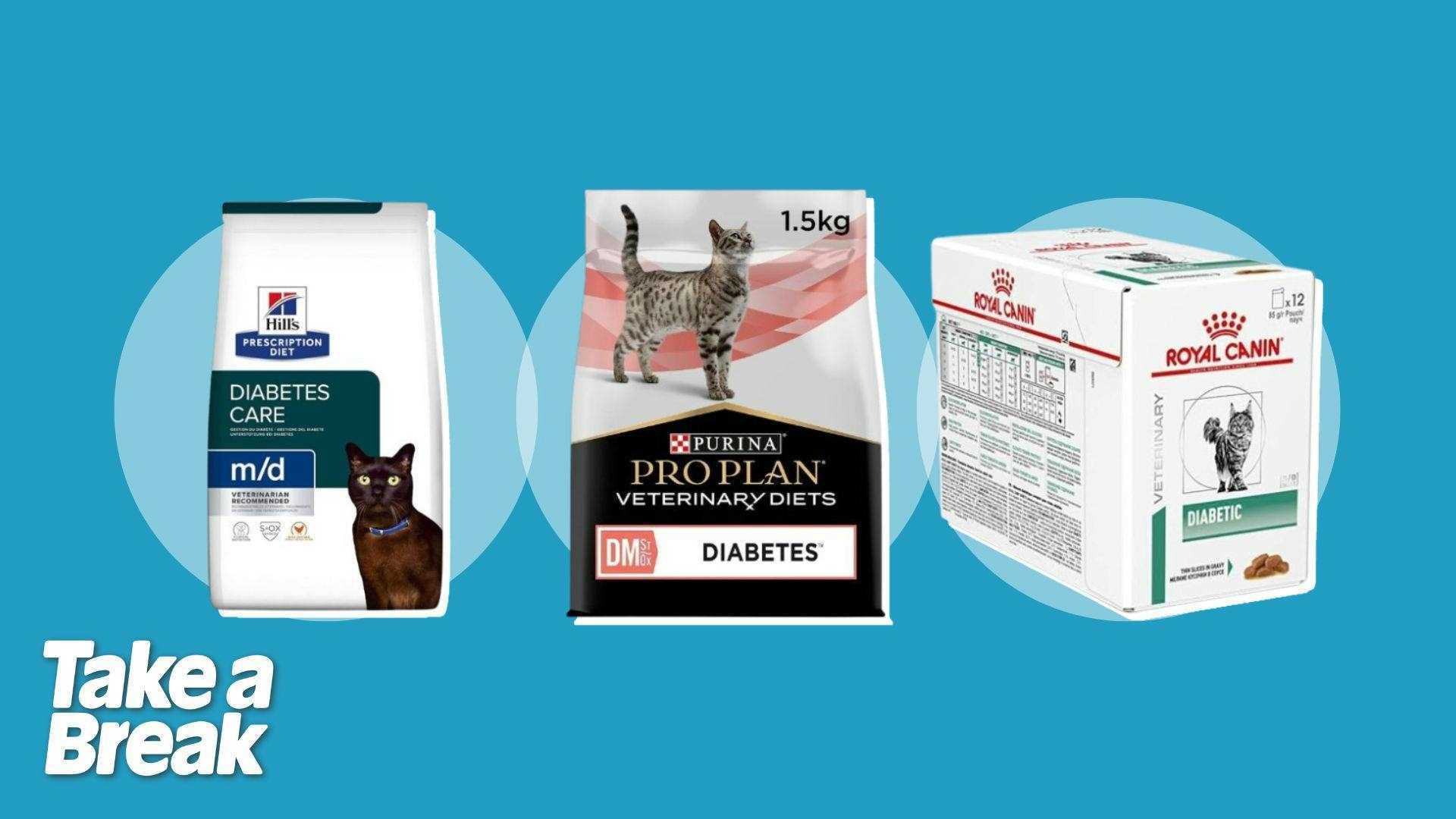




For those caring for a feline with elevated blood sugar levels, selecting appropriate nutrition is critical. This article provides insights into the most suitable options available on the market, ensuring the well-being of your pet while managing their condition effectively.
You’ll find a detailed overview of various brands that specialize in low-carbohydrate and high-protein nutrition designed specifically for felines with insulin resistance. Each option includes ingredient analysis, nutritional benefits, and user reviews to help you make an informed decision.
This guide is particularly beneficial for pet owners seeking to enhance their furry companion’s quality of life through dietary adjustments. By the end, you’ll have a clearer understanding of how to choose the right nutritional products tailored to your pet’s health needs.
Best Dry Cat Food for Diabetic Cats
Selecting the right nourishment for a feline with elevated blood sugar levels is pivotal. Focus on options that feature high-quality proteins and low carbohydrates to help manage glucose levels effectively.
Look for products containing natural ingredients, such as real meat, fish, or poultry as the primary protein source. Incorporating fiber-rich components can also aid in regulating blood sugar. Always consult with a veterinarian to tailor the dietary choices to your pet’s specific needs.
Key Considerations
When evaluating suitable nourishment, consider the following:
- Protein Content: High protein levels are essential to support healthy muscle mass and energy.
- Carbohydrate Levels: Aim for options with lower carbohydrate content to prevent spikes in blood sugar.
- Fiber: Ingredients like beet pulp or pumpkin can assist in stabilizing glucose levels.
- Omega Fatty Acids: These can promote overall health and may help with inflammation.
Always check ingredient labels and consult with a veterinarian for tailored recommendations. Regular monitoring of your pet’s glucose levels can also help determine how well the chosen diet is working.
Understanding the Nutritional Needs of Diabetic Cats
Managing the dietary intake of felines with elevated blood sugar levels requires careful consideration of their nutritional profiles. These animals benefit from a diet that balances protein, carbohydrates, and fats to maintain stable glucose levels and promote overall health.
A high-protein diet is often recommended, as protein helps in building and repairing tissues while also maintaining lean body mass. Additionally, low-carbohydrate options can prevent spikes in blood sugar, supporting better metabolic function.
Key Nutritional Components
It is important to focus on specific components that cater to the unique needs of these animals:
- Protein: Look for quality animal-based proteins that support muscle maintenance and energy levels.
- Fat: Healthy fats are necessary for energy and can help in the absorption of certain vitamins.
- Carbohydrates: Minimize simple sugars and opt for complex carbohydrates that are digested slowly.
- Fiber: Soluble and insoluble fibers can aid in regulating blood sugar and improving digestive health.
Additionally, hydration is crucial. Ensure that fresh water is always available to promote adequate fluid intake, which can aid in kidney function and overall well-being.
Consulting with a veterinarian for personalized dietary recommendations is advisable, as each animal’s health status may differ. Regular monitoring of blood glucose levels will help gauge the effectiveness of the chosen dietary strategy.
Ingredients to Seek in Nutrition for Cats with Glucose Management Needs
High-quality protein sources should be prioritized. These proteins help maintain muscle mass and support overall health. Look for named meat sources such as chicken, turkey, or fish as primary ingredients, as they provide essential amino acids necessary for optimal functioning.
Incorporating low-glycemic carbohydrates is crucial. Ingredients like peas, lentils, or sweet potatoes can offer energy without causing significant spikes in blood sugar levels. It’s beneficial to avoid grains and fillers that may contribute to elevated glucose readings.
Key Nutritional Components
- Fiber: Ingredients like beet pulp and pumpkin can aid in digestion and help regulate blood sugar levels.
- Healthy Fats: Omega-3 and omega-6 fatty acids, found in fish oil or flaxseed, support skin and coat health while providing a balanced energy source.
- Vitamins and Minerals: A blend of essential nutrients, including vitamin E, B vitamins, and minerals like zinc and magnesium, promotes overall wellness and supports metabolic functions.
To ensure your pet’s specific dietary requirements are met, consulting with a veterinarian is recommended. They can guide you in selecting appropriate nutrition tailored to individual health needs.
Brands That Specialize in Diabetic Cat Diets
Certain manufacturers focus on creating nutritional options tailored for pets with specific health needs, including those managing blood sugar levels. These companies prioritize high protein content and low carbohydrate ratios, which are crucial for maintaining stable glucose levels in felines. Their formulations often include ingredients that support overall health while catering to the dietary restrictions required for diabetes management.
The commitment to quality and health is evident in the sourcing of ingredients and the absence of fillers or artificial additives. Many brands conduct extensive research and collaborate with veterinarians to ensure their offerings align with the dietary requirements of pets facing these challenges. This attention to detail helps pet owners feel confident in their choices.
Key Features of Specialized Brands
- High Protein Content: Essential for muscle maintenance and energy.
- Low Carbohydrate Levels: Reduces the risk of glucose spikes.
- Beneficial Additives: Incorporation of omega fatty acids, fiber, and vitamins to support overall health.
- Veterinary Endorsements: Many products are recommended by veterinarians, ensuring they meet specific health standards.
Choosing a brand that emphasizes these qualities can lead to better health outcomes for pets. Owners should always consult with their veterinarians before making dietary changes to ensure the selected options align with their pet’s unique health profile.
Comparative Analysis of Popular Diabetic Dry Cat Foods
Choosing the right nutrition for felines with glucose management issues requires careful attention to ingredient profiles and nutritional balance. Many options are available, each with distinct formulations aimed at regulating blood sugar levels while ensuring overall health.
When evaluating various selections, it is essential to focus on protein content, carbohydrate sources, and fiber levels. High-quality proteins from animal sources are preferable, as they support muscle maintenance and energy without causing spikes in blood sugar. Low-glycemic carbohydrates, such as certain vegetables and grains, can help manage glucose levels effectively.
Key Components to Analyze
- Protein Sources: Look for formulations that list real meat as the primary ingredient. This supports lean body mass and metabolic health.
- Carbohydrate Types: Ingredients such as peas or lentils may be more beneficial than grains like corn or wheat, which can elevate blood sugar levels.
- Fiber Content: Increased fiber can aid in glucose regulation and promote digestive health. Ingredients like beet pulp and psyllium husk are common sources.
- Fat Levels: Healthy fats from fish oil or chicken fat provide energy and support skin and coat health without contributing to weight gain.
Additionally, some products incorporate supplements like omega fatty acids, antioxidants, and vitamins to enhance overall well-being. These can further assist in managing long-term health conditions often associated with impaired glucose regulation.
It is also advisable to consult with a veterinarian before making a switch to ensure that the chosen diet aligns with the specific health needs of the feline. Regular monitoring of weight and glucose levels can help gauge the effectiveness of the selected nutrition.
How to Transition Your Cat to a New Diabetic Diet
Begin the transition by mixing the new nutrition with the current diet. Start with a small ratio of the new product, about 25%, combined with 75% of the existing option. This gradual introduction helps to minimize digestive upset and allows your feline friend to adjust to the new taste and texture.
Over the course of a week, gradually increase the proportion of the new meal while decreasing the old one. Aim for a 50/50 mix by the fourth day. Monitor your pet’s reaction closely during this period, noting any changes in appetite, behavior, or stool quality.
Maintain a Consistent Feeding Schedule
Consistency is key. Feed your animal at the same times each day to regulate their blood sugar levels effectively. Stick to the recommended serving sizes based on their weight and health status, adjusting as necessary based on your veterinarian’s guidance.
As you transition, keep an eye on their weight and energy levels. If any unusual symptoms arise, consult a veterinarian promptly. It’s also beneficial to have a conversation with your vet regarding the specifics of the new diet to ensure it meets all nutritional needs.
Be Patient and Observant
Some animals may take longer to adapt than others. Be patient during this process and provide encouragement. If your pet shows signs of resistance, such as refusing to eat, try reheating the new option slightly or mixing in a small amount of a favorite treat.
- Monitor their hydration levels.
- Gradually reduce the old diet over 7 to 10 days.
- Keep plenty of fresh water available at all times.
Adjustments may be necessary based on individual preferences and responses. Understanding your companion’s behavior during this transition will help in ensuring they adapt successfully to their new nutritional regimen.
Monitoring Your Pet’s Health After Dietary Changes
Regular health assessments are essential after implementing new nutritional strategies. Monitor your pet’s behavior, weight, and overall wellbeing closely to identify any potential issues early on.
Keep a detailed log of your observations, including changes in appetite, energy levels, and litter box habits. This information can be invaluable for veterinary consultations.
Key Indicators to Watch
- Weight Management: Track weight weekly to ensure it remains stable or gradually decreases if overweight.
- Energy Levels: Note any changes in activity; lethargy can signal complications.
- Urination and Thirst: Increased urination or thirst may indicate blood sugar fluctuations.
- Coat Condition: A healthy coat is often a reflection of overall health; monitor for changes in texture or shedding.
Regular Veterinary Check-Ups
Schedule routine vet visits to assess your companion’s glucose levels and overall health. Blood tests can provide insights into how well the new diet is managing their condition.
Adjusting the Plan
If you notice concerning signs, consult with your veterinarian to adjust the dietary plan as needed. Tailoring the approach can lead to better health outcomes.
In conclusion, consistent monitoring and open communication with your veterinarian are key to ensuring your animal thrives on their new nutritional path. Stay proactive in addressing any health concerns as they arise.
Best dry cat food for diabetic cats
Features
| Part Number | 21012 |
| Model | 21012 |
| Warranty | Solid Gold does not warranty product sold through unauthorized resellers as it could be tampered with, expired, stored improperly, transferred improperly, or counterfeit. |
| Color | Chicken & Egg |
| Size | 12 Pound |
Features
| Part Number | 00038100138408 |
| Model | 00038100138399 |
| Warranty | Purina guarantees outstanding quality and taste. If for any reason you’re not satisfied, simply let Purina know why. Please contact Purina directly at (800) 778-7462 within 60 days of date on receipt for assistance. Or, feel free to mail your original purchase receipt with the price circled, a brief explanation of why you were dissatisfied with our products, the “Best If Used By” date box from the package, along with your name and street address (P.O. Box not accepted) to: Purina, Office of Consumer Affairs, P.O. Box 2530, Largo, FL 33779 |
| Release Date | 2024-04-15T00:00:01Z |
| Size | 10 Pound (Pack of 1) |
Features
| Part Number | 038100131546 |
| Model | 13154 |
| Warranty | Purina guarantees outstanding quality and taste. If for any reason you’re not satisfied, simply let Purina know why. Please contact Purina directly at (800) 778-7462 within 60 days of date on receipt for assistance. Or, feel free to mail your original purchase receipt with the price circled, a brief explanation of why you were dissatisfied with our products, the “Best If Used By” date box from the package, along with your name and street address (P.O. Box not accepted) to: Purina, Consumer Services, PO Box 340, Neenah WI 54957 |
| Release Date | 2022-02-24T00:00:01Z |
| Size | 16 Pound (Pack of 1) |
| Publication Date | 2011-12-21T00:00:01Z |
Features
| Part Number | 70 |
| Model | 70 |
| Warranty | If you have a question that needs immediate attention, please call (800) 919-2833. |
| Color | Brown |
| Size | 12 Pound (Pack of 1) |
Features
| Part Number | 2660 |
| Model | 02660 |
| Warranty | No warranty |
| Color | Blue |
| Release Date | 2018-01-01T00:00:01Z |
| Size | 6.6 Pound (Pack of 1) |
Features
| Part Number | 017800144100 |
| Model | 00017800144100 |
| Color | Other |
| Release Date | 2023-01-23T00:00:01Z |
| Size | 22 Pound (Pack of 1) |
| Publication Date | 2011-09-01T00:00:01Z |
Video:
FAQ:
What are the key ingredients to look for in dry cat food for diabetic cats?
When choosing dry cat food for diabetic cats, it’s important to focus on high protein and low carbohydrate content. Look for foods that list high-quality meat sources, such as chicken, turkey, or fish, as the first ingredient. Additionally, the presence of fiber, such as beet pulp or pumpkin, can help regulate blood sugar levels. Avoid foods with excessive grains, fillers, or sugars, as these can lead to spikes in blood glucose levels.
How can I tell if the dry cat food I choose is suitable for my diabetic cat?
To determine if a dry cat food is suitable for your diabetic cat, check the nutritional information on the packaging. Look for a guaranteed analysis that shows high protein (around 40% or more) and low carbohydrates (ideally below 10%). You can also consult with your veterinarian for recommendations based on your cat’s specific health needs. Additionally, brands that are formulated specifically for diabetic cats often indicate this on their packaging, making them a more reliable choice.
Are there any specific brands of dry cat food recommended for diabetic cats?
Several brands are known for producing dry cat food that is suitable for diabetic cats. Popular options include Hill’s Prescription Diet m/d, Royal Canin Diabetic, and Purina Pro Plan Veterinary Diets DM. These brands offer formulations designed to help manage blood sugar levels. It’s advisable to consult with your veterinarian before making a switch to ensure that the chosen food meets your cat’s unique dietary requirements.










